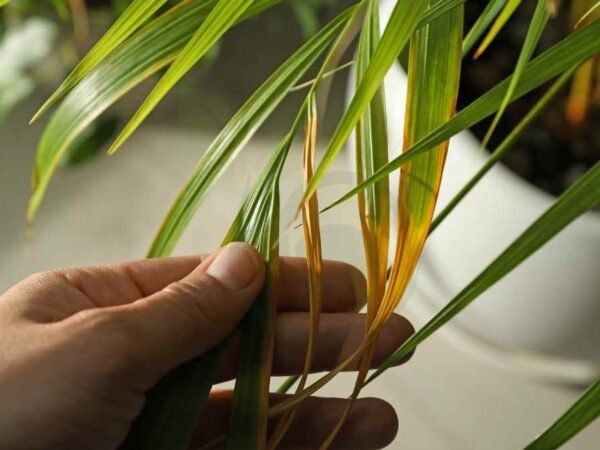
Transform your garden from messy to magnificent by mastering the art of trimming Areca palms. Discover how a few simple techniques can make a striking difference in your outdoor space. Learn the dos and don'ts of trimming to ensure your palms stay healthy and vibrant year-round.
Unleash the full potential of your garden with expert tips on shaping and maintaining Areca palms and other plants. Say goodbye to overgrown, untidy foliage and hello to a well-manicured paradise right outside your door. Elevate your gardening game, water your plants, compost for leaf production, and create a stunning outdoor oasis that will leave your neighbors green with envy.
Key Takeaways
- Regularly prune your Areca palms to cut dead leaves, maintain their health, appearance, and leaf production.
- Follow seasonal pruning guidelines to ensure optimal growth and vitality.
- After pruning, provide proper post-care to support the plant's recovery.
- Address common issues promptly through troubleshooting techniques.
- Manage the size and shape of your Areca palms to fit your space and aesthetic preferences.
- Propagate your Areca palms using recommended techniques for expanding your plant collection.
Areca Palm Overview
Origin Characteristics
Areca palms originate from Madagascar and are also known as butterfly palms due to their delicate, feathery fronds. These palms can grow to heights of around 20 feet.
Growth Rates
Areca palms typically have moderate growth rates, thriving in optimal conditions with proper care. Factors like light exposure, watering frequency, nutrient levels, and fertiliser influence plants' growth rates. Varying care practices, such as adjusting watering schedules or providing more sunlight, can impact the speed at which Areca palms grow.
Environmental Factors
Environmental factors play a crucial role in the health of Areca palms. Adjusting care based on factors like humidity levels, temperature, and light intensity is essential for maintaining their well-being. Specific environmental stressors, including dry air, direct sunlight, and cold drafts, can negatively affect Areca palms if not addressed promptly.
Planting Areca Palm
Key Steps
Areca palms require regular care routines to thrive. Trim yellowing or damaged leaves promptly. Ensure adequate sunlight exposure for optimal growth. Monitor soil moisture levels regularly to prevent overwatering.
Maintain optimal growth and appearance by fertilizing Areca palms with fertiliser every 2-3 months. Prune dead fronds to encourage new growth. Protect the plants from pests by inspecting leaves and flowers for signs of infestation.
Soil Preferences
Areca palms thrive in well-draining soil rich in organic matter and compost. Opt for a well-aerated mix to promote root health. Ensure the soil pH ranges between 6.1-7.5 for optimal nutrient absorption.
Select a potting mix designed for palm plants or create a blend of peat moss, perlite, and sand. Avoid compacted soils that hinder root development. Amend the soil with compost to enhance fertility.
Watering Needs
Maintain consistent soil moisture levels for Areca palms without allowing waterlogging. Water when the top inch of soil feels dry to the touch. Use room temperature water to avoid shocking the roots.
Ensure proper drainage in pots to prevent water accumulation at the roots. Adjust watering frequency based on environmental conditions such as temperature and humidity levels. Consider using a self-watering system for convenience.
Pruning Techniques
Identifying Fronds
Areca palms require regular pruning to maintain their health and aesthetics. When identifying fronds for trimming, focus on brown or wilted leaves of areca palm. These indicate the need for removal to encourage new growth.
Yellowing Management
- Yellowing leaves in Areca palms can signal nutrient deficiencies, overwatering, or the need for fertiliser or compost.
- To manage yellowing effectively, adjust watering frequency and consider fertilizing with a balanced formula.
- Prevent yellowing by ensuring proper drainage and providing adequate light exposure.
Slow Regrowth
Factors like poor soil quality or insufficient sunlight can lead to slow regrowth in Areca palms. To promote faster regrowth, consider repotting in fresh soil and relocating to a sunnier spot. Signs of slow regrowth include stunted new leaves or a lack of vibrant green color.
Achieving Symmetry
Symmetry is crucial for enhancing the visual appeal of Areca palms. Maintaining a balanced plant shape involves regular trimming to prevent overcrowding. To achieve visual harmony, prune older fronds at varying heights to create a layered effect.
Tools Required
When trimming Areca palms, essential tools include pruning shears, gloves, and a ladder for reaching tall fronds safely. Pruning shears help make clean cuts without damaging the plant. Gloves protect your hands from sharp edges and potential irritants on the leaves.
- Pruning shears: Ideal for cutting through thick fronds with precision.
- Gloves: Protect your hands from scratches and potential allergens.
- Ladder: Essential for reaching tall fronds safely without risking injury.
Quality tools like Fiskars Pruning Shears and Pine Tree Tools Bamboo Working Gloves are recommended for efficient care of Areca palms.
Seasonal Pruning Guide
Best Seasons
Areca palms thrive when trimmed during the spring and summer months, promoting healthy growth. Prune in early spring to remove dead or damaged fronds, enhancing the plant's appearance. Adjust watering and fertilizing schedules based on seasonal variations to support optimal growth.
- Pros: Spring pruning encourages new growth and rejuvenates the plant for the upcoming season.
- Cons: Pruning in late summer may stress the plant due to reduced sunlight exposure.
Growth Monitoring
Monitoring growth in Areca palms is crucial for ensuring their well-being. Look for vibrant green fronds and sturdy leaf bases as signs of healthy palm growth. Keep track of new leaf development and overall plant size to gauge progress accurately over time.
- Regularly inspect leaf bases for any signs of discoloration or wilting.
- Measure the height of the palm every few months to track its vertical growth rate.
Health and Beauty Maintenance
Fertilizing Practices
Areca palms require effective fertilizing to thrive. Maintaining a nutrient balance is crucial for optimal plant growth. Utilize balanced fertilizers rich in essential nutrients like nitrogen, phosphorus, and potassium.
Fertilizing Areca palms with fertiliser and compost ensures they receive the necessary nutrients for healthy development. Adequate fertilization supports vibrant foliage and robust growth. Use slow-release fertilizers to provide a steady supply of nutrients over time.
- Pros: Promotes healthy growth, enhances foliage color.
- Cons: Over-fertilization can lead to nutrient imbalances.
Air Circulation Improvement
Good air circulation is vital for Areca palms as it prevents stagnant air around the plant. To enhance airflow, place the plant where it can receive gentle breezes or indirect sunlight. Avoid placing it in drafty areas to prevent stress on the plant.
Improving air circulation around Areca palms helps in preventing diseases caused by poor ventilation. Prune any overcrowded foliage to allow better airflow within the plant. Regularly dust off leaves to ensure optimal photosynthesis.
- Trim overcrowded foliage.
- Avoid placing in drafty locations.
Pest Prevention
Common pests that affect Areca palms include spider mites and mealybugs. To safeguard your plant, regularly inspect for signs of infestation such as webbing or sticky residue on leaves. Treat affected areas promptly with insecticidal soap or neem oil.
Preventive measures like maintaining proper humidity levels and regular leaf cleaning help deter pests. Create a pest-free environment by periodically wiping down leaves with a damp cloth and isolating any infested plants to prevent spread.
- Spider mites and mealybugs are common pests.
- Regular inspection and early treatment are key prevention methods.
Managing Size and Shape
Trimming for Size
Trimming Areca palms for size is crucial to maintain their aesthetic appeal and prevent overcrowding. Regular trimming ensures that the plant stays at a manageable height and width, preventing it from outgrowing its space. By controlling the size through trimming, you can also promote better air circulation and sunlight exposure for the plant.
To safely trim Areca palms for size, start by using sharp and clean pruning shears to avoid damaging the plant. Focus on removing any overgrown or dead fronds while maintaining the overall shape of the palm. Make clean cuts at an angle to prevent tearing or injuring the plant. prune back any damaged or discolored stems to encourage new growth and maintain the health of the palm tree.
Achieving the desired size and shape of Areca palms through trimming requires careful planning and consistent maintenance. Monitor the growth of the plant regularly and trim as needed to prevent it from becoming too large or unruly. By regularly shaping the palm tree, you can create a visually appealing appearance while ensuring its long-term health and vitality.
Promoting New Growth
Promoting new growth in Areca palms is essential for maintaining their lush appearance and overall health. To encourage healthy regrowth, provide adequate water, sunlight, and nutrients to support the plant's development. Regularly fertilize the soil around the palm to ensure it receives essential nutrients for robust growth.
Encouraging continuous growth and development in Areca palms involves pruning old or yellowing fronds to make way for new growth. By removing dead or decaying foliage, you allow space for fresh shoots to emerge, promoting a vibrant and green canopy. Consider repotting the palm tree every few years to refresh its soil and stimulate new root growth.
Post-Pruning Care
Immediate Steps
After trimming Areca palms, it's crucial to address any immediate issues. Immediate steps include checking for signs of stress like yellowing leaves or drooping fronds. If such symptoms are present, adjust watering and lighting conditions promptly.
For urgent plant care, consider providing extra humidity by misting the palm or using a humidifier nearby. Ensure adequate drainage to prevent waterlogging, which can lead to root rot. If there are any damaged areas post-pruning, trim them further to promote healing.
In critical situations, such as pest infestations or diseases, swift action is necessary. Identify the specific issue affecting the palm and apply appropriate treatments immediately. Quarantine the affected plant if needed to prevent the spread of pests or diseases to other plants in your garden.
Long-Term Care Tips
To maintain healthy Areca palms in the long run, consistent care is key. Implement a regular watering schedule, ensuring the soil remains moist but not waterlogged. Consider using a well-balanced fertilizer every few months to provide essential nutrients for growth.
Sustainable practices like repotting the palm every 2-3 years can help prevent root-bound issues and promote healthier growth. Prune dead or yellowing fronds regularly to enhance air circulation and maintain the plant's aesthetic appeal. Over time, this consistent care will result in lush, vibrant Areca palms.
Consistent long-term care offers various benefits for Areca palms. It promotes robust growth, reduces the risk of pests and diseases, and enhances the overall appearance of the plant. By investing time and effort into maintaining your Areca palm properly, you can enjoy a thriving and beautiful indoor greenery.
Troubleshooting Common Issues
Pruning Challenges
Pruning Areca palms can pose challenges, such as over-pruning leading to stress and reduced growth. Maintaining plant health requires careful pruning techniques. To overcome challenges, avoid excessive trimming and focus on removing only dead or damaged fronds.
Consider the plant's overall appearance before pruning to ensure a balanced look. Regularly inspect for signs of pests or diseases that may affect the plant's health. Sterilize tools between cuts to prevent the spread of infections and maintain plant vigor.
Yellowing Fronds Tips
Managing yellowing fronds in Areca palms involves identifying root issues, nutrient deficiencies, or inadequate sunlight exposure. To address yellowing leaves, start by trimming affected fronds close to the main stem. Ensure proper watering and fertilization to promote new growth.
Create a regular watering schedule based on the plant's needs and adjust light exposure if necessary. Consider using a balanced fertilizer to provide essential nutrients for healthy leaf development. Monitor progress closely after implementing changes to see improvements in leaf color.
Pest Infestation Solutions
Dealing with pest infestations in Areca palms requires prompt action to prevent further damage. Integrated pest management techniques involve using natural predators or organic solutions to control pests effectively. Remove affected fronds and dispose of them properly to limit pest spread.
Inspect plants regularly for early signs of infestation, such as webbing or discoloration on leaves. Treat affected areas with neem oil or insecticidal soap to eradicate pests gently. Implement preventive measures like introducing beneficial insects or maintaining proper plant hygiene.
Propagation Techniques
Propagating Steps
To propagate Areca palms, start by selecting a healthy offshoot or seed. Plant it in well-draining soil and keep it moist but not waterlogged. Remove any dead leaves regularly to encourage growth. Monitor for pests and diseases.
When propagating from offshoots, carefully separate them from the parent plant using a sharp, sterilized knife. Ensure that each offshoot has roots attached for successful propagation. Plant the offshoot in a separate pot with well-draining soil.
For propagation from seeds, soak them in warm water for 24 hours before planting. Sow the seeds in a shallow layer of soil and keep them consistently moist until germination occurs. Provide warmth and indirect sunlight for optimal growth.
Tips for Successful Propagation:
- Maintain consistent moisture levels without overwatering.
- Place newly propagated plants in a warm, humid environment.
- Regularly check for signs of root development to ensure successful growth.
Care After Propagation
After propagating Areca palms, continue to provide proper care to ensure their long-term health and growth. Water young plants regularly, allowing the soil to dry slightly between waterings. Avoid overwatering to prevent root rot.
Young propagated plants require indirect sunlight and warm temperatures to thrive. Protect them from direct sunlight, which can cause leaf burn. Rotate the plants periodically to promote even growth on all sides.
To nurture propagated Areca palms for long-term growth, gradually transition them to their desired environment. Increase light exposure slowly over time to acclimate the plants without causing stress. Fertilize lightly during the growing season to support healthy foliage.
Guidance for Long-Term Care:
- Gradually expose plants to more sunlight as they mature.
- Monitor for pests and diseases regularly and take prompt action if detected.
- Provide occasional misting or use a humidifier to maintain humidity levels.
Final Remarks
You've now mastered the art of trimming Areca palms, ensuring they thrive and enhance your space. From planting to post-pruning care, you've learned the essential techniques for maintaining their health and beauty. Remember to follow the seasonal pruning guide and troubleshoot common issues promptly to keep your Areca palms in top condition.
Incorporate these tips into your routine to enjoy lush, vibrant Areca palms year-round. Share your newfound knowledge with fellow plant enthusiasts and continue exploring different propagation techniques to expand your green oasis. Keep nurturing your Areca palms with care and precision for a stunning botanical display in your home or garden.
Frequently Asked Questions
How often should I trim my Areca palms?
Trim your Areca palms at least once a year, preferably in late winter or early spring. Regular pruning helps maintain the plant's health and appearance.
What tools do I need for trimming Areca palms?
You will need sharp pruning shears or loppers to trim Areca palms effectively. Make sure to clean your tools before and after use to prevent the spread of diseases.
Can I shape my Areca palm while trimming?
Yes, you can shape your Areca palm during trimming by selectively removing fronds to achieve the desired look. Ensure not to remove more than one-third of the foliage at a time to avoid stressing the plant.
How do I care for my Areca palm after trimming?
After trimming, water your Areca palm thoroughly and place it in a location with indirect sunlight. Avoid fertilizing immediately after pruning to allow the plant time to recover.
How can I troubleshoot common issues post-trimming my Areca palm?
If you notice browning or yellowing fronds after trimming, it may indicate over-pruning. Ensure proper watering and light conditions, and avoid cutting healthy fronds excessively. If issues persist, consult a plant expert for further guidance.
Image Source: Paid image from CANVA





